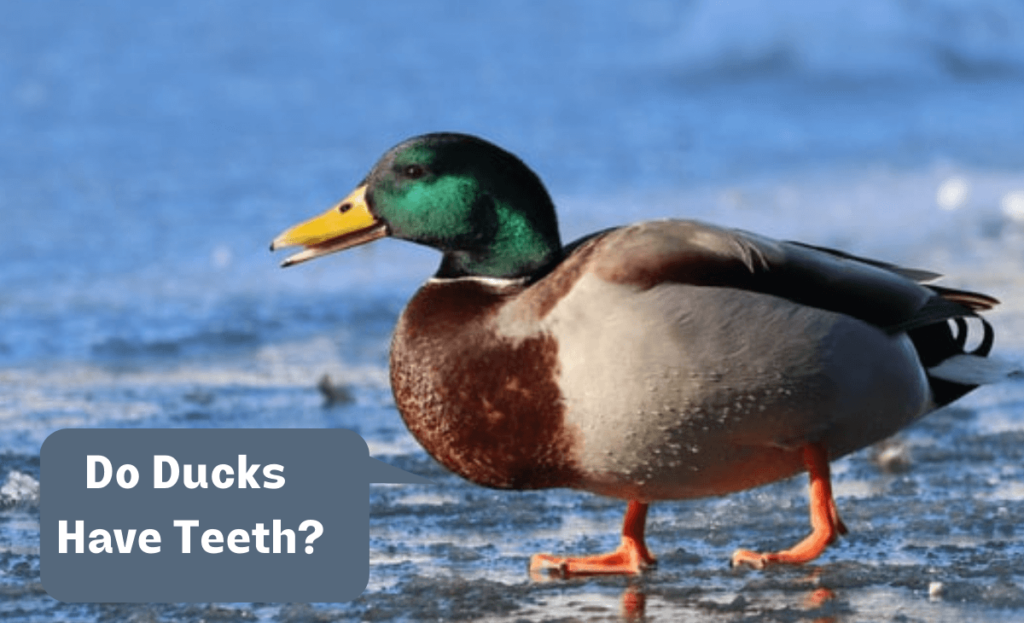Ducks are beautiful and fascinating animals, and it’s easy to see why so many people love them. If you see them in water, they are like swan-like creatures with long necks and beaks that are always ready to go fishing. You’re maybe one of those people who have seen many ducks in your life, but you never actually paid attention to whether they had teeth. But what about those teeth? Do ducks have teeth? How many teeth do they have?
In this article, you will learn everything you need to know about ducks and their teeth.
History of Ducks and Their Teeth
Just like the other species of birds, ducks are fascinating, and we are only beginning to understand all of their secrets.
Many people keep ducks as pets, but they have been around for much longer. In fact, these birds have been around for over 30 million years! Fossils of ducks have been found dating back to the Cretaceous period, which means that they were around even when dinosaurs roamed the earth.
Their closest relatives are geese and swans, and two other waterfowl. They all descend from the same ancestor.
Humans have used their eggs, meat, and feathers for centuries, and some cultures even worshiped them.
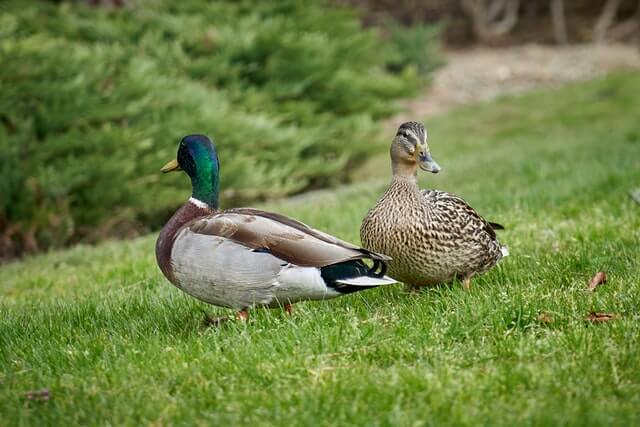
So, Do Ducks Have Teeth?
It’s a common misconception that ducks do not have any teeth.
In actuality, ducks have teeth-like structures that are called “papillae.” These are very small, keratinized projections that line the inside of a duck’s mouth, and they have 28 to 32 of those. These are tiny and are located on the edges of their bills. Despite the fact that duck teeth are not real teeth, they serve to break up food and prevent it from sliding out of its mouth.
What are Duck Bills?
A distinguishing feature of the duck is the “duck bill”. The duck’s bill is flat and often has serrated edges. This feature has special sensory receptors that enable them to find food and helps them to filter food out of the water.
Although duck bills may look similar, each duck species has a slightly different bill shape adapted to their food as they have a varied diet.
Do ducks chew food with bills? No, they don’t. The slight movement of bills helps ducks swallow food in the whole bites.
Other birds that feed on food from water may have flattened bill shape beaks.
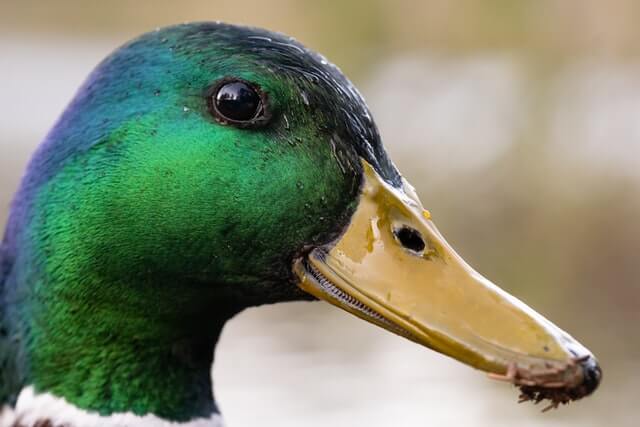
Spatulate Shape
Some ducks have specialized bill structures. They have spoon-shaped bills, known as spatulate bills. This type of duck’s bill helps with filter-feeding. The duck uses its bill to scoop up water and then sifts through the water to find food.
Some of the most common species with spatulate bills include:
-Shovelers
-Pochards
-Teal
Pectinate Shape
The bills of other ducks are comb-like, known as a pectinate bill. This type of bill is adapted for picking up food from the bottom of a body of water. The pet duck uses its comb-like bill to rake through the mud.
Some of the most common ducks with pectinate bills include:
-Dabblers
-Mallards
-Wigeons
What’s Inside the Duck’s bill
- Nail-like Tubercles: The bills of some ducks have tiny, nail-like tubercles. These tubercles help pet ducks grip their food.
- Glands: These produce a waxy substance that helps to waterproof the duck’s feathers
- Nostrils: These allow her to breathe while underwater
Lamellae
Ducks also have something called lamellae in their bills. Lamellae are tiny, hairlike structures that help them filter their food. Lamellae are especially helpful for them they eat small aquatic creatures like crustaceans. The lamellae help the duck sift through the water and pick out its food.
Grin Patch
The bills of some ducks have patches of bare, fleshy skin called a grin patch. It helps the duck grip its food. The grin patch is beneficial for these birds that eat slippery prey like fish.
Duck Bristles
Duckbills also have special sensory receptors that help them to find food. These receptors are called bristles, located around the edges of the duck’s bill. The bristles help detect vibrations in the water, which can indicate the presence of food.
These are just a few of the adaptations that these birds have developed in order to survive. These adaptations help them find and eat food and avoid being eaten by predators.

Two Classes of Ducks
Dabbling ducks
Dabbling ducks are the most common type of duck, and they are often the kind that people think of when they think of ducks.
These famous birds include species such as mallards, wood ducks, and teals.
These birds feed by tipping their bodies forward and scooping food off the water’s surface with their bills. These birds usually eat aquatic plants, insects, and small fish.
Diving ducks
Diving ducks are less common than dabbling ducks, but they are still found in many parts of the world.
The diving ducks include species such as mergansers and scaups. These birds feed by diving underwater to find food. They usually eat aquatic plants, small fish, and crustaceans.
Both dabbling and diving ducks are adapted to their respective feeding methods. The former have bills shaped like paddles, which help them scoop food off the water’s surface. While the latter have bills that are shaped like tubes, which allow them to suck in food from the bottom of a pond or lake.
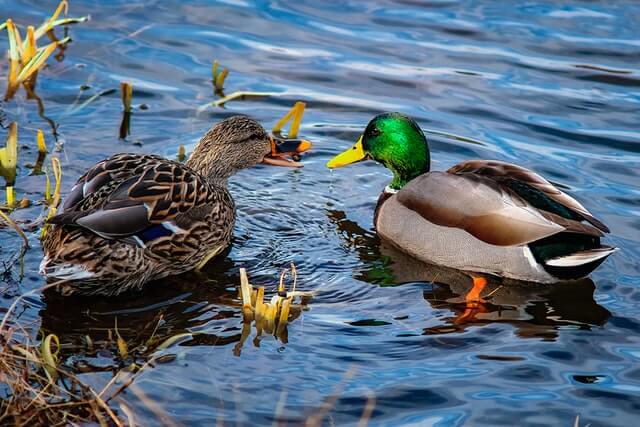
Can You Feed Ducks?
Do Ducks Eat Rocks?
No, ducks do not eat rocks. While they may occasionally peck at stones or other objects, they do not actually consume them. Rocks can be harmful to these birds if they swallow them. It can cause an internal blockage that could be fatal.
Do Ducks Eat Only Fish?
No, domestic ducks do not eat only fish. Ducks occasionally eat more fish, but they are not strictly carnivorous. Their natural diet consists of both plants and animals, so they are omnivorous birds too. In addition to fish, ducks eat other foods like insects, crustaceans, and other small creatures.
Can You Feed Duck Bread?
Yes, you can feed duck bread. They are not picky eaters, and they will often eat whatever food is available to them. However, their digestive systems do not have the capacity to handle large amounts of bread. So, feeding ducks bread in large amounts can cause health problems.
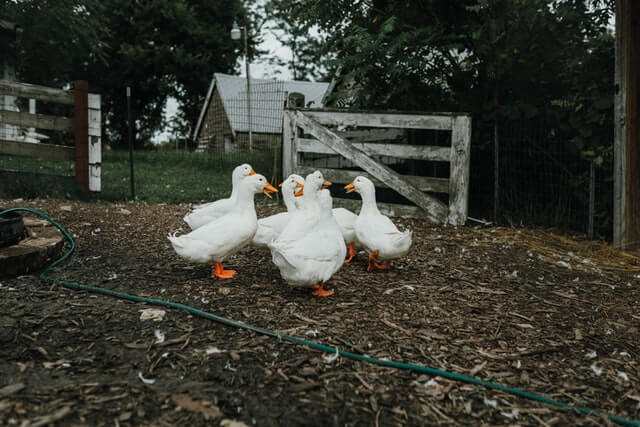
Duck teeth: How to keep them healthy
Duck’s teeth, called beaks, don’t work like ours or most animals. They don’t chew their food but swallow it whole instead.
If you’re thinking of raising ducks or other birds alike, here are some tips to help keep the beak healthy:
1. Keep Their Beak Clean
Like our teeth, plaque and bacteria can build up on the beak if we don’t brush them regularly. You can clean the beak by gently rubbing it with a wet cloth.
2. Keep Their Beak Trimmed
If you notice that the beak is getting too long, you can trim it with a nail file or emery board. But be careful not to cut too much—you don’t want to hurt your duck!
3. Provide Them with Plenty of Water
Water is essential for a duck’s health, and it can also help keep its beak clean and healthy. Make sure your duck has access to clean fresh water.
4. Feed Them a Healthy Diet
A healthy diet is essential for a duck’s overall health, and it can also help keep its beak healthy. Ducks need a diet that is rich in protein and low in fat. You can give your duck a variety of foods that contains a nutritional value such as vegetables, fruits, grains, and even insects.
5. Take Them to the Vet
If you notice anything unusual about the beak of your duck, such as discoloration, cracks, or excessive growth, take them to the Vet. A vet can help diagnose any problems and recommend treatment.
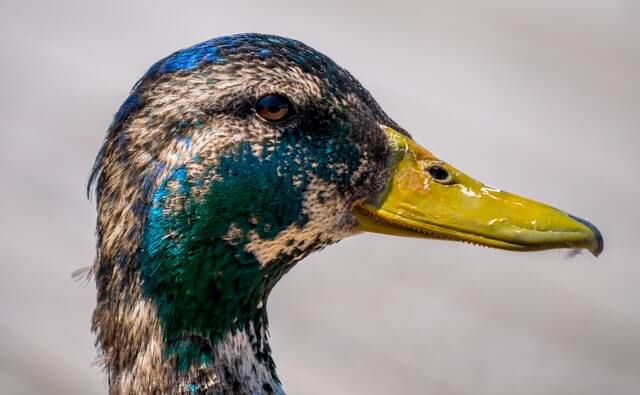
Duck FAQ’S
Can Ducks Bite?
Yes, they can. Most ducks bite when threatened. Their sharp beaks enable them to tear apart their food. If you approach a duck from behind, it may think you are a predator and try to bite you.
Female ducks tend to bite other animals to protect their offspring.
Do all Ducks Have Teeth?
No, not all duck species have teeth. Some do not have any teeth at all. These bird species are called toothless ducks and include Pekin, Muscovy, and East Indian. Still, they have lamellae in their bills to help filter their food.
What Do Ducks Use Their Wings For?
Ducks use their wings for flying, but they also use them for swimming. When they are swimming, they use their wings to help them move through the water.
Do Ducks Sleep in Water?
No, ducks do not sleep in the water. They usually sleep on land, in a safe place where they hide from predators. However, if there is a danger of predators, ducks may rest in the water to stay safe.
Do Duck Bites Hurt?
Yes, duck bites can hurt. Ducks don’t have teeth but they have a sharp beak that they use to tear apart their food. It may feel like a needle piercing your skin if they bite you. However, ducks usually only bite if they feel threatened. If you approach a duck from behind, it may think you are a predator and try to bite you.
What Makes Ducks Such Great Swimmers?
Ducks are great swimmers because they have several adaptations that help them in the water. They have webbed feet that allow them to paddle through the water. They also have waterproof feathers, which enable them to float. In addition, ducks have a layer of fat under their skin, which provides them with insulation and buoyancy.
Final Thoughts – ducks don’t have teeth like structures
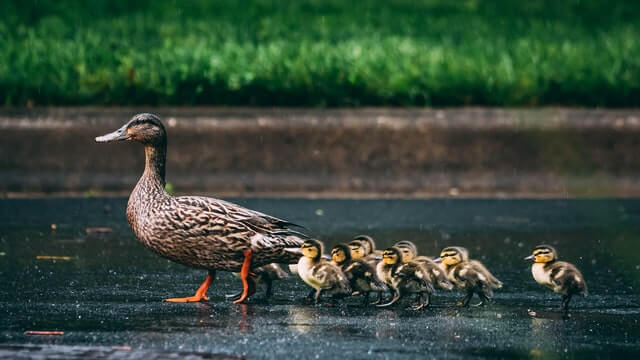
Now that you know the answer to the question, “Do ducks have teeth?” You can better understand how these fascinating creatures live and function. They are exciting and have many unique adaptations that help them survive in their environment.
Even though ducks don’t have teeth, they have many similar features that help them eat and live just like any other animal. Hence, they still need to take care of their beaks. Follow the tips above to help keep your duck’s beak healthy and happy.
The next time you see a duck, take a closer look and see all the fantastic things that these creatures can do!

